Opinion
The 'Plight' of the Community Team
Community teams faced harsh criticism post-Cup, but are they really the only ones that fell short of expectations?
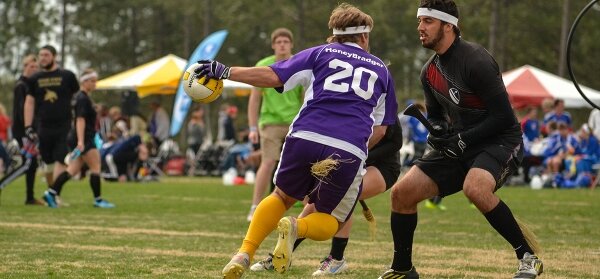
Ethan Sturm overreacted and you should be pissed about it.
Not actually, but I couldn’t resist. In his article on Monday, Sturm laid into the various community teams, in particular criticizing the NYDC Capitalists, the Lost Boys, QC Boston: The Massacre (QCB) and Lone Star Quidditch Club (LSQC) for what he perceived as their World Cup failures.* While I think Sturm very accurately describes some of the struggles that community teams face, his column suffers one fatal flaw: his premise is flat out incorrect.
Many teams didn’t live up to their internal expectations, but from an outside perspective, it’s hard to attribute those problems as a direct result of being a community team. The struggle of community teams at World Cup was a statistical irregularity of the type that occasionally happens when you rely too much on small sample sizes, and jump to conclusions because of confirmation bias. World Cup was a single tournament over a course of two days. Most of the outcomes discussed were dependent on the result of a single game.
What perhaps best frames this conversation is an excerpt from the article “Five Bold Predictions” I wrote for the Monday Snitch on July 1, hailing the rise of community teams.
“It would not shock me if half of the American regions are won by community teams. In addition to the previously discussed Capitalists, who are my pick to win the Mid-Atlantic, the Lost Boys are in my opinion the favorites in the West, while the newly-forming Q.C. Boston Massacre (Boston, MA) have a good shot in the Northeast.”
This was written prior to any knowledge being credibly leaked about LSQC or Florida’s Finest pervading the national dialogue. I likely would have picked at least one of them to take a regional championship.
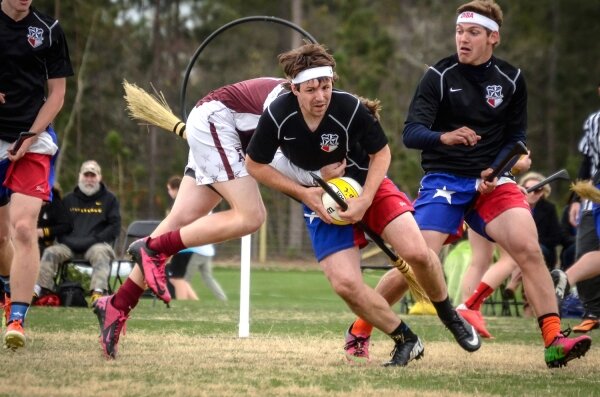
Perhaps then you can blame me for being one of the first on the community team “hype-train,” but I bring this up not to tout my own year-old ignorance, but to remind us of the dialogue of a year ago.
When did we go from thinking half of the regional championships being won by community teams was a bold prediction to expecting community teams to take World Cup while earning all four final four spots, solve world hunger and create world peace? In my defense, I wasn’t far off in my prediction. The Lost Boys took the West, Lone Star was the Southwest runner up, NYDC reached the Mid-Atlantic semifinals and Florida’s Finest and QC Boston each reached the quarterfinals of their respective regions.
Let us now take a look at how the various community teams fared at World Cup VII.
Pool 1
Utah Crimson Fliers: A year after failing to qualify, the Crimson Fliers finished second in its pool, which also featured Southern Regional Champions the University of Miami and eventual World Cup runner-ups Texas State University--who handed Utah its only pool play loss. It’s hard to view anything Utah did as a disappointment after such a strong rebound.
Pool 3
Valhalla: A case of a team being happy just to qualify. Hugh Podmore brought quidditch to an area that did not have any standing teams and had few experienced players available for recruitment. Valhalla’s qualification is an accomplishment in and of itself.
Pool 4
Lost Boys: The Lost Boys ran into a disastrous matchup. Did chemistry contribute to their demise as Sturm suggested? Possibly. But what truly failed the Lost Boys at World Cup was the schedule. Louisiana State University (LSU) was a terrible matchup for this team. The Lost Boys all year featured star beaters, a good passing game and, while the team faced few SWIM situations, many suspected they also possessed a reliable seeker. At World Cup they ran into a team that had played them previously (Diamond Cup) and had analyzed their film. LSU eliminated the Lost Boys by doing its homework, neutralizing the Lost Boys beaters and pulling a clutch snitch. Basically the story of the Lost Boys is the story of March Madness. Anything can happen in one game, and if a team has a good game plan and executes it, it can pull an upset. LSU did just that, but that doesn’t mean that the Lost Boys failed. In this case, it means LSU played a great game and the Lost Boys lost once in a single-elimination tournament.
Pool 5
NYDC: NYDC drew into what many considered the “Pool of Death,” and within that pool drew just about the worst possible schedule. Everyone knew the Santa Barbara Blacktips (SBB) were talented but lacked depth. NYDC drew SBB in its first game. Austin Quidditch was, as everyone suspected, a team that was criminally punished by the tough schedule it faced and was likely underseeded. Michigan Quidditch showed up with an incredibly strong, experienced team and put together a day one performance that appears to be the best that team has played all year. Like the Lost Boys, NYDC ran into a really tough schedule that did them in. NYDC lost fleetingly this season, earning a top-10 ranking throughout the year and finishing with an official record of 28-5.
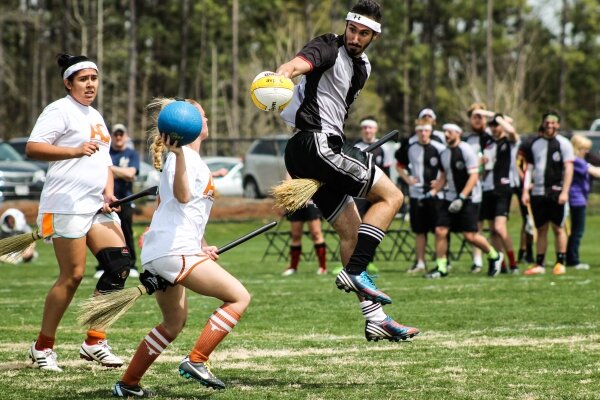
SBB: SBB is a community team that draws largely from a college and perhaps doesn’t belong on this list. However, it’s worth mentioning that the addition of Andy Abayan during the spring season--a classic community team move--aided them greatly. I think many would have been shocked before the season to see this team that only qualified for World Cup VI via deferred bid, make bracket play at World Cup VII.
New York Badassilisks: There isn’t much to say here, but qualifying for Division I, even with an expanded field, is an improvement on last year. They’ve been around longer than many college teams though, and this seems to be the proper caliber for this squad. They seem to have performed commensurate with expectations.
Pool 7
Silicon Valley Skrewts: The Skrewts are an engine that just keeps chugging along. After nearly missing out on World Cup VII during qualification, the Skrewts topped their pool on the back of veterans returning from injury and new recruit Alex Makk. It seems every year you expect the Skrewts to be around the top five in the West and advance to the Round of 32 or 16, and they always do.
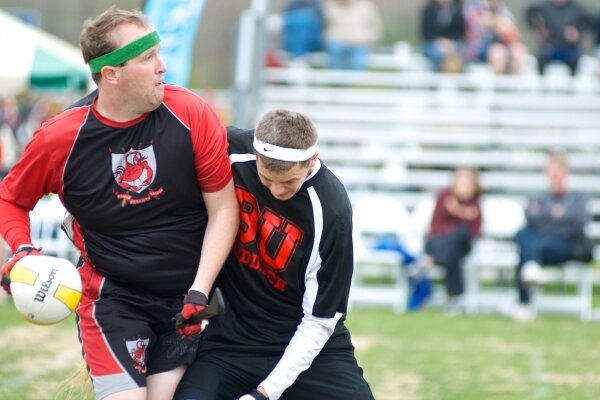
Pool 8
Florida’s Finest: Florida’s Finest was knocked out in the Round of 16 by Emerson College--a team that reached the final four and was consistently one of the top teams this year with wins over Mid-Atlantic Regional Champions the University of Maryland and Northeast Regional Champions Boston University this season. Florida’s Finest did its part to redeem the Southern Region after a disappointing showing at World Cup VI.
Pool 10
Steel City Quidditch Club: Steel City turned in an 11-6 record and was an overtime loss from advancing to the World Cup VII bracket. An experienced team SCQC posted its best year, and surprised many with an exciting run through the consolation bracket to qualify for World Cup at the Mid-Atlantic Regional Championship.
Long Beach Funky Quaffles: The Long Beach Funky Quaffles (LBFQ) surprised many, though probably not those based out West, just by making the bracket. While LBFQ ultimately fell to the University of Florida in overtime in its first bracket game, this squad improved by leaps and bounds over where it was a year ago. Its World Cup qualification and bracket performance are indicative of this team’s success and bright future.
Pool 12
TC Frost: This newly formed community team qualified for World Cup in its first ever official tournament. The strong debut didn’t stop there as the young squad earned a World Cup win over an experienced University of South Florida, a team that advanced to the Southern Regional Championship semifinals.
Pool 14
QC Boston: This team’s performance is perhaps the toughest to explain. QCB went 1-2 in its pool when the opportunity was there for a much better performance. QCB then fell in overtime on a pair of snitch catches to Rochester Institute of Technology, which, given how QCB played all season, feels like a just result. The reality with this team is that it launched with a bang, announcing itself via a pair of 2012 Team USA chasers, and everyone overreacted to that announcement. QCB is the team that proves quidditch is truly a team sport, not one made up of individuals. All year the squad lacked depth--something not unusual for a first-year team be it college or community--and wasn't as good as we all decided it had to be.
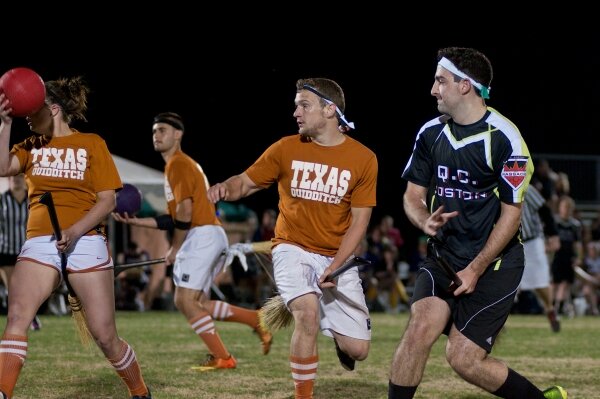
Pool 15
Lone Star Quidditch Club: Lone Star was an undisputed top-five team this year. Of course it featured its fair share of stars, but it’s tough to call a top-five team that continuously lost to the No. 1 ranked team a disappointment. The bottom line with Lone Star was Texas A&M University--who many considered the top team all year--just had Lone Star’s number. Sturm may be right that more practice would have served LSQC well, but the fact that Lone Star’s only snitch-range loss to Texas A&M in four matches happened at World Cup suggests that the team actually improved throughout the year relative to the college team. However, in reality, a World Cup where you enter with a 19-5 record, secure a top-five seed after pool play and lose in the Elite Eight to the top team in the league 100*-70 is hardly a disappointment.
Sturm writes about the failures of community teams, but really what he was noticing was confirmation bias, looking at the data and seeing what you want to see, combined with the failures of a small sample size. Four out of 61 North American Division I qualifiers at World Cup VI were community teams (Skrewts, Lost Boys, the Blacktips, who were unable to attend and QC Carolinas). This year there were 13 out of the 87 North American qualifiers. Even with a rash of graduates in the quidditch community, this number seems to be disproportionately larger than one might expect.
Many community teams underachieved at World Cup VII, but you know who else failed to live up to expectations? Texas A&M, Baylor University, Boston University, Bowling Green State University, Michigan State University, the University of Miami and really the list goes on and on and on. Picking out four teams that all happen to be community teams and claiming they underachieved is easy. You know who I think really underachieved? Regional champions. Let’s look at the fate of the seven regional champions present...
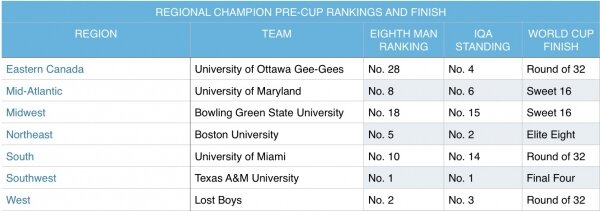 Stats courtesy of the Eighth Man and the IQA
Stats courtesy of the Eighth Man and the IQA
It’s true that some community teams may have performed below expectations (although not without reason), but one could argue that regional champions underperformed as well. Perhaps being dominant in their regions, each of these teams was overconfident in its success and didn’t practice hard enough. Maybe each was plagued by the famously coined “Disease of More”, where by virtue of the team’s early success, players thought they were better than they were. Another theory: these successful teams had played a bunch of blowouts against lesser teams and didn’t know how to react in tight games under pressure. Allow me to put forward one final idea: I’m making all of this up based on convenient possible explanations. I’m looking for a theory that will explain what I want to find and the reality is that in one tournament--and a single elimination tournament at that (well largely anyway)--a small group of teams with a central trait displayed a combination of bad luck and poor performance.
When you look at the data long enough, with a certain goal in mind, you’ll always find what you want to see.
Let me leave you with a quote.
"Pardon me," said Milo to the first man who happened by; "can you tell me where I am?"
"To be sure," said Canby; "you're on the Island of Conclusions. Make yourself at home. You're apt to be here for some time."
"But how did we get here?" asked Milo, who was still a bit puzzled by being there at all.
"You jumped, of course," explained Canby. "That's the way most everyone gets here. It's really quite simple: every time you decide something without having a good reason, you jump to Conclusions whether you like it or not. It's such an easy trip to make that I've been here hundreds of times."
-The Phantom Tollbooth, Norton Juster
*This article focuses on teams that do not feed from specific colleges and formally identify themselves as community teams.

